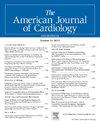Prevalence and Prognostic Differences Between Sarcopenia and Sarcopenic Obesity in Heart Failure
IF 2.1
3区 医学
Q2 CARDIAC & CARDIOVASCULAR SYSTEMS
引用次数: 0
Abstract
Evidence directly comparing sarcopenia and sarcopenic obesity in hospitalized heart failure (HF) patients, especially in young and middle-aged individuals, remains limited. This study aimed to (1) investigate the prevalence and clinical characteristics of sarcopenia and sarcopenic obesity, and (2) compare their prognostic impacts on adverse outcomes to identify protective body composition phenotypes. The findings are hypothesized to provide new perspectives on the HF obesity paradox. This prospective cohort study was conducted from June 2022 to October 2023. The primary endpoint was 1-year HF-related readmission or all-cause mortality. Prolonged hospital stays and 90-day HF-related readmission or all-cause mortality were set as secondary outcomes. Associations of sarcopenia and sarcopenic obesity with poor clinical outcomes were analyzed using multivariate logistic regression and Cox proportional hazards regression. Sarcopenia and sarcopenic obesity prevalence were 26.4% (n = 57) and 19.4% (n = 42) among 216 participants, with malnutrition present in 77.2% (44/57) and 71.4% (30/42) of cases, respectively. After adjusting for covariates, both sarcopenia and sarcopenic obesity independently predicted 1-year HF-related readmission or all-cause mortality (sarcopenia vs nonsarcopenia: HR = 2.048 [95% CI:1.064∼3.940], p = 0.032; sarcopenic obesity vs nonsarcopenic obesity: HR = 1.932 [95% CI:1.062∼3.515], p = 0.031). Sarcopenic obesity also independently predicted the prolonged hospital stay (OR = 2.418 [95% CI:1.050∼5.567], p = 0.038). In conclusion, hospitalized HF patients were susceptible to sarcopenia, sarcopenic obesity, and the double burden of malnutrition and obesity. Muscle mass, rather than fat mass, may exert protective effects, which could partially explain the HF obesity paradox. Interventions aimed at reducing obesity while ensuring the maintenance of, or an increase in, muscle mass should be developed.
心力衰竭患者肌肉减少症和肌肉减少性肥胖的患病率及预后差异。
直接比较住院心力衰竭(HF)患者肌肉减少症和肌肉减少性肥胖的证据仍然有限,特别是在年轻人和中年人中。本研究旨在(1)调查肌肉减少症和肌肉减少性肥胖的患病率和临床特征,(2)比较它们对不良结局的预后影响,以确定保护性身体成分表型。这些发现被假设为HF肥胖悖论提供了新的视角。这项前瞻性队列研究于2022年6月至2023年10月进行。主要终点是1年hf相关再入院或全因死亡率。延长住院时间和90天hf相关再入院或全因死亡率作为次要结局。采用多因素logistic回归和Cox比例风险回归分析肌肉减少症和肌肉减少性肥胖与不良临床结果的关系。在216名参与者中,肌肉减少症和肌肉减少性肥胖患病率分别为26.4% (n=57)和19.4% (n=42),营养不良发生率分别为77.2%(44/57)和71.4%(30/42)。调整协变量后,肌少症和肌少性肥胖均可独立预测1年hf相关再入院或全因死亡率(肌少症vs.非肌少症:HR=2.048[95%CI:1.064 ~ 3.940], P=0.032;肌少性肥胖vs.非肌少性肥胖:HR=1.932[95%CI:1.062 ~ 3.515], P=0.031)。肌少性肥胖也独立预测住院时间延长(OR=2.418[95%CI:1.050 ~ 5.567], P=0.038)。综上所述,住院HF患者易发生肌少症、肌少性肥胖、营养不良和肥胖双重负担。肌肉量,而不是脂肪量,可能发挥保护作用,这可以部分解释HF肥胖悖论。应该制定旨在减少肥胖的干预措施,同时确保维持或增加肌肉质量。
本文章由计算机程序翻译,如有差异,请以英文原文为准。
求助全文
约1分钟内获得全文
求助全文
来源期刊

American Journal of Cardiology
医学-心血管系统
CiteScore
4.00
自引率
3.60%
发文量
698
审稿时长
33 days
期刊介绍:
Published 24 times a year, The American Journal of Cardiology® is an independent journal designed for cardiovascular disease specialists and internists with a subspecialty in cardiology throughout the world. AJC is an independent, scientific, peer-reviewed journal of original articles that focus on the practical, clinical approach to the diagnosis and treatment of cardiovascular disease. AJC has one of the fastest acceptance to publication times in Cardiology. Features report on systemic hypertension, methodology, drugs, pacing, arrhythmia, preventive cardiology, congestive heart failure, valvular heart disease, congenital heart disease, and cardiomyopathy. Also included are editorials, readers'' comments, and symposia.
 求助内容:
求助内容: 应助结果提醒方式:
应助结果提醒方式:


